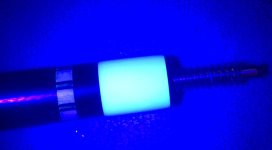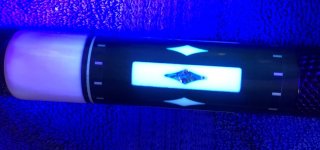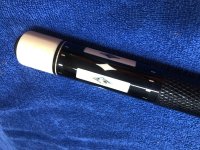That was new cues built for the show. There were plenty of Ivory inlaid cues on display from the collectors.I have never thought that.
It's just that the matter can get complicated.
The recent ICCS had exactly zero ivory in any of the cues by agreement of the participants.
You are using an out of date browser. It may not display this or other websites correctly.
You should upgrade or use an alternative browser.
You should upgrade or use an alternative browser.
Advice on selling ivory-inlayed cue.
- Thread starter Qslave
- Start date
Can you clarify what Rule #1 is?.Again, do not read anyone's interpretation read what is written...
From the Federal BAN:
INTERSTATE COMMERCE
"The final rule includes the following changes for interstate commerce:
• Further restricts interstate commerce to only:
1. items that meet the criteria of the ESA antiques exemption,
2. certain manufactured or handcrafted items that contain a small (de minimis) amount of ivory.**
• Prohibits interstate commerce in:
1. ivory imported under the exceptions for a household move or inheritance, or for law enforcement or genuine scientific purposes, and
2. sport-hunted trophies.
" Selling ACROSS state lines is prohibited 100%. Regardless of the state’s permissions and acceptance of ivory.
UNLESS Rule 1 or Rule 2 is met."
This means that selling ivory from Tennessee to Texas is technically a federal crime unless the cue is accompanied by a de minimus declaration (letter). In addition, there may be a requirement to verify the dates as specified in the rule if it was requested during a confiscation.
This is why I sought out AND received the OK, from FWS, for authoring a de minimus letter. However, it will be almost impossible to produce other documents which they are requesting, because they were never needed or saved and passed on.
Billiard cues over 100 years old will meet the ESA exemption. The import rule for modern day cues is #2. Here it is, in its entirety.
** Rule 2
** To qualify for the de minimis exception, manufactured or handcrafted items must meet ALL OF the following criteria:
- (i) If the item is located within the United States, the ivory was imported into the United States prior to January 18, 1990, or was imported into the United States under a Convention on International Trade in Endangered Species of Wild Fauna and Flora (CITES) pre-Convention certificate with no limitation on its commercial use.
- (ii) If the item is located outside the United States, the ivory was removed from the wild prior to February 26, 1976.
- (iii) The ivory is a fixed or integral component or components of a larger manufactured or handcrafted item and is not in its current form the primary source of the value of the item, that is, the ivory does not account for more than 50% of the value of the item.
- (iv) The ivory is not raw.
- (v) The manufactured or handcrafted item is not made wholly or primarily of ivory, that is, the ivory component or components do not account for more than 50% of the item by volume.
- (vi) The total weight of the ivory component or components is less than 200 grams (7.05 oz); AND
- (vii) The item was manufactured or handcrafted before the effective date of this rule. (July 6th, 2016)
JV
Rule #2 is spelled out clearly above.
Thanks. Yeah, I was already corrected. I misunderstood.That was new cues built for the show. There were plenty of Ivory inlaid cues on display from the collectors.
Chris,Can you clarify what Rule #1 is?.
Rule #2 is spelled out clearly above.
Rule 1 is the ESA exemption in antiques.
* To qualify for the ESA antiques exemption, an item must meet all of the following criteria [seller/importer/exporter must demonstrate]:
A. It is 100 years or older.
B. It is composed in whole or in part of an ESA-listed species;
C. It has not been repaired or modified with any such species after December 27, 1973; and
D. It is being or was imported through an endangered species ‘‘antique port.’’
Under Director’s Order No. 210, as a matter of enforcement discretion, items imported prior to September 22, 1982, and items created in the United States and never imported must comply with elements A, B, and C above, but not element D.
In theory a BBC model 26.5 or a 360 would qualify to rule 1 as would an ivory billiard ball. However, if you replaced the ivory joint in said cue after 12/27/73 it would not.
Some states that adopted this rule, only did so in pieces. Some of the states have that the B. Cannot be an entire object, only a small amount of volume of said object.
JV
So, on the matter at hand, I bought a "good" shaft used for what I felt was a good deal. Bonus surprise is I am pretty darn sure it has an ivory ferrule that was not advertised. It turns out it is a good shaft but does not fit the pin stated by the seller. It's a 14 pin advertised as an 18 pin. So, it will not fit the cue I intended it for. It is an excellent shaft and fits other cues I have but the rings don't match. Fits my Joss perfectly for example, straight as an arrow.
Additional problem, it was shipped in a flimsy box which was predictably damaged. There is a very fine shallow dent, out of the stroking area, not in the finished area, and wood fibers are intact. Easy fix. Not a big deal, but also not my fault.
So, considering these issues, what shall I do?
Return it? That's illegal as far as I can tell. The original transaction was illegal as far as I can tell.
It's an eBay seller that says on their page they don't accept returns, but we know I can get my money back. That's not my question.
This is all theoretical for the federal bots that are crawling here. Purely a supposition. I don't think I have ever seen any ivory let alone, bought, owned, or sold any.
Here is a pic of the pilot/joint ring in case you are interested. 1 1/8 inch ivory ferrule. 29 1/4 inches. Thoughts on the origin?

Additional problem, it was shipped in a flimsy box which was predictably damaged. There is a very fine shallow dent, out of the stroking area, not in the finished area, and wood fibers are intact. Easy fix. Not a big deal, but also not my fault.
So, considering these issues, what shall I do?
Return it? That's illegal as far as I can tell. The original transaction was illegal as far as I can tell.
It's an eBay seller that says on their page they don't accept returns, but we know I can get my money back. That's not my question.
This is all theoretical for the federal bots that are crawling here. Purely a supposition. I don't think I have ever seen any ivory let alone, bought, owned, or sold any.
" Selling ACROSS state lines is prohibited 100%. Regardless of the state’s permissions and acceptance of ivory.
UNLESS Rule 1 or Rule 2 is met."
Here is a pic of the pilot/joint ring in case you are interested. 1 1/8 inch ivory ferrule. 29 1/4 inches. Thoughts on the origin?
Blacklight the ferrule to be sure. You can hassle the seller, and if it is ivory, that gives you bonus leverage.So, on the matter at hand, I bought a "good" shaft used for what I felt was a good deal. Bonus surprise is I am pretty darn sure it has an ivory ferrule that was not advertised. It turns out it is a good shaft but does not fit the pin stated by the seller. It's a 14 pin advertised as an 18 pin. So, it will not fit the cue I intended it for. It is an excellent shaft and fits other cues I have but the rings don't match. Fits my Joss perfectly for example, straight as an arrow.
Additional problem, it was shipped in a flimsy box which was predictably damaged. There is a very fine shallow dent, out of the stroking area, not in the finished area, and wood fibers are intact. Easy fix. Not a big deal, but also not my fault.
So, considering these issues, what shall I do?
Return it? That's illegal as far as I can tell. The original transaction was illegal as far as I can tell.
It's an eBay seller that says on their page they don't accept returns, but we know I can get my money back. That's not my question.
This is all theoretical for the federal bots that are crawling here. Purely a supposition. I don't think I have ever seen any ivory let alone, bought, owned, or sold any.
Here is a pic of the pilot/joint ring in case you are interested. 1 1/8 inch ivory ferrule. 29 1/4 inches. Thoughts on the origin?
View attachment 854102
JV
Going to get a light tomorrow. Don't have one. They have them cheap at harbor freight. Meant to grab one numerous times and didn't.Blacklight the ferrule to be sure. You can hassle the seller, and if it is ivory, that gives you bonus leverage.
JV
It's actually not too big of a deal for me, I'll handle it. It wasn't expensive either, so I'm not really worried about the money. But as far as how it contributes to this discussion, I thought it was serendipitous that it came up with this thread being active.
I'll post results.
Under a black light ivory is bright. For those that do not know how to check. Someone told me some new stuff shows bright, but I haven't seen it. In the butt sleeve the cap is not ivory and you can see the result.
JV
JV
Attachments
Goodness gracious, this is so simple. If Chopdoc lives in a state that has an ivory ban, he broke the law buying the shaft.
So although he is now in possession of a cue shaft with an ivory ferrule, he can only sell & ship it when he’s not in state.
If he is in a free state, he can buy any cue shaft or any pool cue at any time as long as it meets the Interstate Comerce
regulation that allows certain manufactured or handcrafted items that contain a small (de minimis) amount of ivory to be sold and shipped. Pool cues & cue shafts fall under the de minimis exemption but remember to comply with your state’s laws.
So it seems pretty clear……sellers & buyers only need to worry if they live in a state that passed legislation restricting
ivory. If you do not, go ahead and buy or sell your pool cue because it is legal. But remember if you sell it to a buyer in
a state where he just broke the law, your could get legally entangled with the buyer’s prosecution if that were to occur.
Additionally, the reverse is true if you just bought a cue from a seller that violated his state law banning the sale of ivory. You could wind up paying for a cue that never reaches you and lose your payment for the cue with little recourse. So don’t make a mountain out of a mole hill re: ivory. It’s not complex or complicated. Just adhere to the aforementioned and you’ll be fine.
Classic Cues post #44 provides a complete explanation or visit Recollection Cues website for another great explanation.
So although he is now in possession of a cue shaft with an ivory ferrule, he can only sell & ship it when he’s not in state.
If he is in a free state, he can buy any cue shaft or any pool cue at any time as long as it meets the Interstate Comerce
regulation that allows certain manufactured or handcrafted items that contain a small (de minimis) amount of ivory to be sold and shipped. Pool cues & cue shafts fall under the de minimis exemption but remember to comply with your state’s laws.
So it seems pretty clear……sellers & buyers only need to worry if they live in a state that passed legislation restricting
ivory. If you do not, go ahead and buy or sell your pool cue because it is legal. But remember if you sell it to a buyer in
a state where he just broke the law, your could get legally entangled with the buyer’s prosecution if that were to occur.
Additionally, the reverse is true if you just bought a cue from a seller that violated his state law banning the sale of ivory. You could wind up paying for a cue that never reaches you and lose your payment for the cue with little recourse. So don’t make a mountain out of a mole hill re: ivory. It’s not complex or complicated. Just adhere to the aforementioned and you’ll be fine.
Classic Cues post #44 provides a complete explanation or visit Recollection Cues website for another great explanation.
Last edited:
If it's so simple, why is your post so long?Goodness gracious, this is so simple.
I'll say this, I don't trust LEO. The shaft will not be returned if it's ivory. I won't ship it.
The only question for me is how I will address it with the seller, they say no returns/refunds. I move 7 figures through PayPal so if I call them I get a live American on the phone and a refund in about a minute.
The question is whether or not there is risk and what the risk might be. There is the law, and there is how LEO interprets that, and what actions they take based on that.
Of course this is all theoretical. I don't have any ivory...
Chopdoc, my post is detailed with examples because I have posted explanations countless times over the past decade
and it keeps returning as a topic that few people answer correctly. Classic Cues post spelled out the law >20 replies ago.
Either Mark or Joe I’m imagining answered this again in reply #64, albeit a shorter version. So if anyone cannot figure
out what they can and can’t do, despite my See Spot Run explanation, are just….uh….I dunno…..reading impaired?
and it keeps returning as a topic that few people answer correctly. Classic Cues post spelled out the law >20 replies ago.
Either Mark or Joe I’m imagining answered this again in reply #64, albeit a shorter version. So if anyone cannot figure
out what they can and can’t do, despite my See Spot Run explanation, are just….uh….I dunno…..reading impaired?
I get it. I follow.Chopdoc, my post is detailed with examples because I have posted explanations countless times over the past decade
and it keeps returning as a topic that few people answer correctly.
Seriously.
Elforyn looks a lot like that under blacklight. I was curious what genuine ivory would look like as I don't have any. If anyone has both and the time, I'd love to see them side by side.Under a black light ivory is bright. For those that do not know how to check. Someone told me some new stuff shows bright, but I haven't seen it. In the butt sleeve the cap is not ivory and you can see the result.
JV
I have not seen Elforyn or SuperTusk under black light. However I will say that if I knew that one of the things FWS was going to do, was to blacklight a cue. I would NOT want them to look the same under the light. OR I would put a laser print tag onto the product to say "Not Ivory" only visible under said light. I would be raging if I paid for a cue that I knew had no ivory, and it was confiscated under a blacklight check. Then only to be destroyed.Elforyn looks a lot like that under blacklight. I was curious what genuine ivory would look like as I don't have any. If anyone has both and the time, I'd love to see them side by side.
As I said, you have to prove it isn't they do not have to prove it is.
JV



